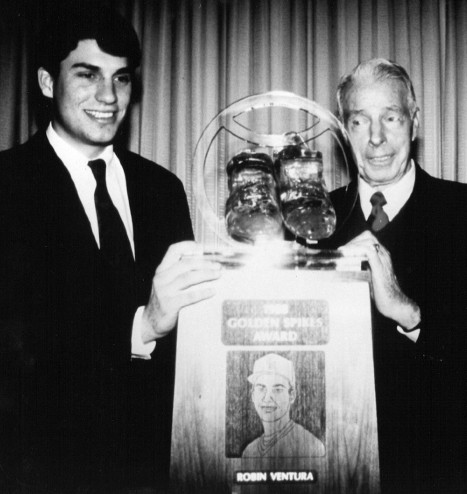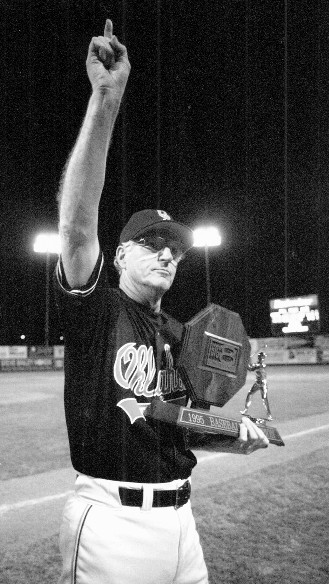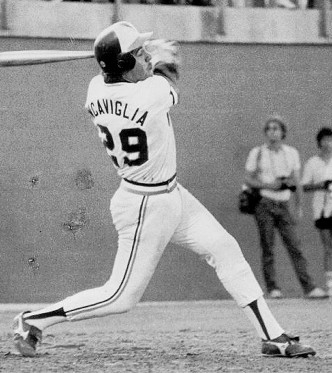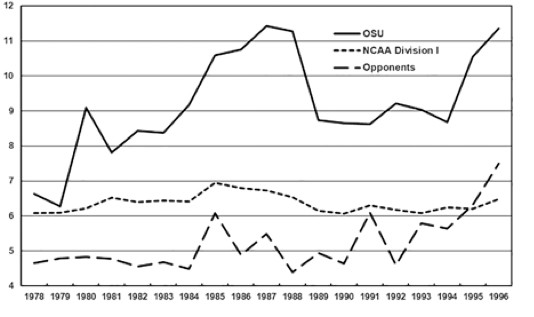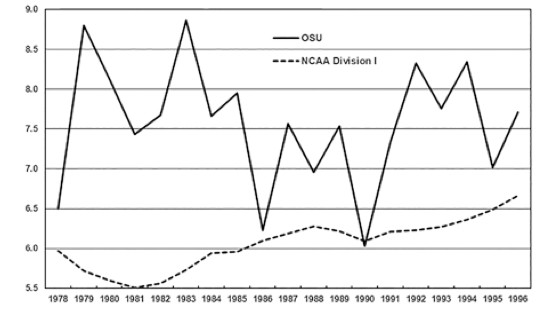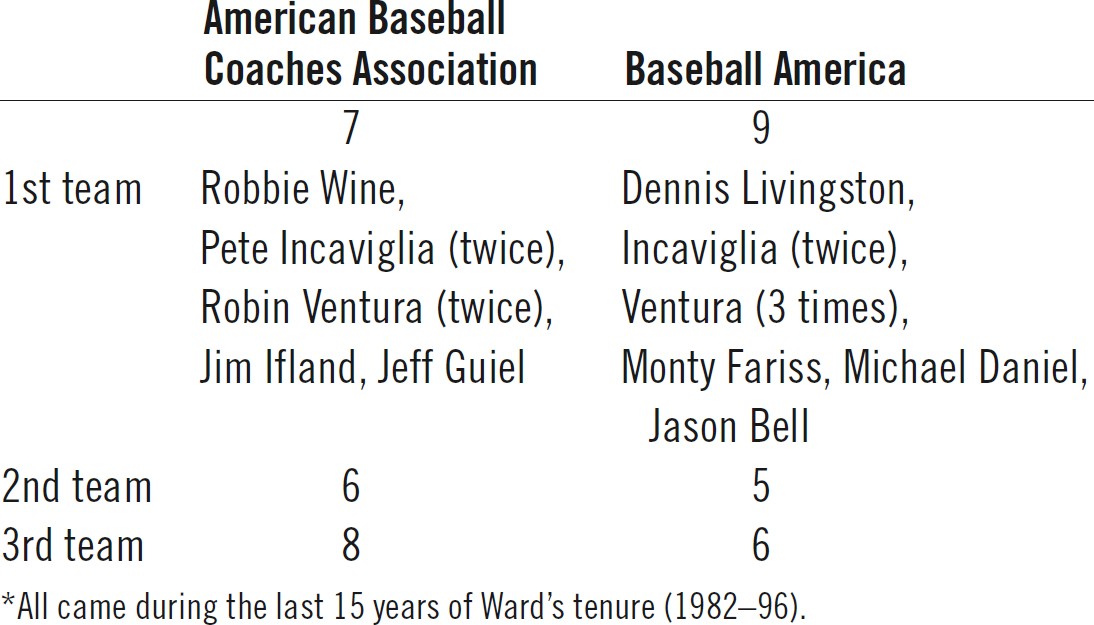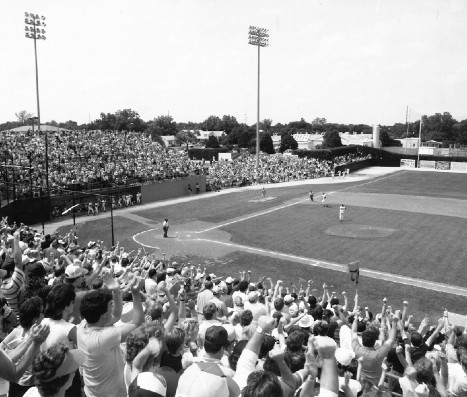Oklahoma State Cowboy Baseball: The Remarkable Gary Ward Years
This article was written by Wade McWhorter - Ronald Elliott
This article was published in The National Pastime: Baseball in Texas and Beyond (2025)
Gary Ward with the Big 8 conference championship trophy in 1995, the 15th of 16 consecutive league championships. (Oklahoma State Athletics)
Founded in Stillwater, Oklahoma, in 1890, Oklahoma A&M College (OAMC) became Oklahoma State University (OSU) in 1957. The school fielded its first baseball team in 1909 and from then through the 1977 season, 11 head coaches combined for a record of 823-538-3 (.605 winning average).1 OSU joined the Big 8 conference in 1958.2 Over the 15 seasons from 1954 through 1968, the Aggies/Cowboys went to eight College World Series, winning the national championship in 1959 and finishing 2nd (twice), 3rd (twice), 4th, 5th, and 7th. However in five of the next nine seasons (1969-77), the Cowboys’ record was below .500.3
Gary Ward grew up on a farm and ranch near Ramona, Oklahoma, learning the value of hard work from his father. Ward played basketball (on scholarship) and baseball at New Mexico State University.4 From 1971 to 1977 he was the head baseball coach at Yavapai Junior College in Prescott, Arizona. Ward enjoyed considerable success, compiling a record of 240-83 (.743) and winning national championships in 1975 and 1977. He was twice named the NJCAA Coach of the Year.5
In May 1977 OSU hired Ward to be its head baseball coach.6 He hit the ground running. Rex Holt, radio voice of the Cowboys, commented: “When we heard him at the press conference, he blew everyone away. You believed everything he said.”7 Ward recruited Tom Holliday, one of his players at Yavapai and then on the staff at Arizona State, to be the pitching coach and recruiting coordinator. That was the beginning of a fruitful, 19-year coaching partnership.
Coach Ward inherited a very subpar playing field. Per Holt, “the University Park was not as good as most small high school stadiums.”8 Ward immediately saw the need for, and value of, a new, modern facility. He was “the driving force behind the planning, funding, design and construction of Allie P. Reynolds Stadium.”9 Ward later said “everything that we saw follow got its genesis in the collective power and emotion and inspiration created around Reynolds Stadium and the building of it.”10 OSU played its first game in Reynolds Stadium on April 4, 1981, and the official dedication was held on April 24, 1982.11 Those attending included not only Allie Reynolds himself but also Mickey Mantle, Bill Dickey, Warren Spahn, and Henry Iba (Reynolds’ baseball coach at OAMC and legendary college and Olympic basketball coach).
The classic home run swing of Pete Incaviglia. (Oklahoma State Athletics)
TEAM ACCOMPLISHMENTS
Over the 19 seasons from 1978 through 1996, Gary Ward’s teams had an overall record of 953-313-1 (.753).12 The Cowboys averaged just over 50 wins per season and were 61-15 in 1984 and an outstanding 618 (.884) in 1988.13 In the decade of the 1980s, OSU had the second highest winning average among all Division I teams.14 Their 30 consecutive wins in 1986 set a Big 8 record.15
Ward’s tutelage helped to make OSU baseball an offensive juggernaut. Over 19 seasons and more than 41,000 at bats, the Cowboys posted a slash line of .321/.444/.531.16 The NCAA has compiled annual “statistical trends” for all Division I teams reporting.17 This includes well over 200 teams in each of the years 1978 through 1996. On a year-by-year basis, Figure 1 compares the average runs scored per game by: OSU, their opponents, and Division I teams. The differences are striking. OSU averaged an amazing 11+ runs per game in 1987, 1988, and 1996. In 1988 the Cowboys outscored their opponents by an average of 6.9 runs per game. Over the 19 years that Ward served as head coach, the average score of the 1267 games was 9.3 (OSU) to 5.2 (opponent).18 The Cowboys led the nation in runs scored per game for four consecutive seasons (1985-88) and again in 1995 and 1996.19
In 1986 the Cowboys set the NCAA record for walks in a season (607). They also hold the 3rd, 4th, and 5th spots in that list (1985, 1996, 1987).20 Throughout Ward’s tenure, the walk rate was .172 per plate appearance.21 Ward’s hitters were known for being very selective at the plate, waiting for a pitch in their “zone.” But the Cowboys also hit for power, as evidenced by their .531 slugging average over the 19 seasons. Not surprisingly, OSU set many Big 8 offensive records during the Ward years. These include hits, runs, and home runs in a season, and consecutive games played without being shut out (269).22
Although not as heralded as the offense, Cowboy pitchers more than held their own during the Ward/Holliday era. For example, Figure 2 looks at season-by-season data on strikeouts per nine innings. Cowboy hurlers bested the Division I average in 18 of the 19 years and in five of those, the difference was more than two strikeouts per nine innings pitched. Reynolds Stadium had the reputation of being a hitters park, but in 14 of the 19 seasons OSU’s team ERA was less than the Division I average.23
Postseason success further cemented the Cowboys’ profile of dominance during the Ward era. OSU won the Big 8 tournament and became the conference’s automatic qualifier for NCAA Regional play in Ward’s first year (1978) and then in each of his last 16 years (1981-96). This incredible run of 16 straight conference championships is a national record.24 During that span the Cowboys posted an overall record of 56-10 (.848) in the conference tournaments.25 Ward’s teams advanced to the College World Series ten times, with an NCAA record seven consecutive appearances from 1981-87.26 The Cowboys played in three CWS championship games (1981, 1987, 1990), each time falling short of the elusive prize. The 1990 scenario was perhaps the most heartbreaking. Two years earlier a format change had led to two four-team double-elimination brackets, with the winners appearing in a one-game championship. After sailing through its bracket undefeated, winning by scores of 14-4, 7-1, and 14-3, OSU lost the championship to a once-defeated Georgia team by a score of 2-1.27
Using Collegiate Baseball’s final poll from each season, the Cowboys were the only school in the country to be ranked in the top 15 in each season from 1981 through 1996.28 The same was true for Baseball America’s final polls over those 16 seasons.29 For both Collegiate Baseball and Baseball America, eight of the 16 final rankings were top 5 and four more were top 10. Clearly, OSU was consistently in the upper echelon of college baseball for an extended period of time.
Robin Ventura (58 games) and Joe DiMaggio (56 games) at the 1998 Golden Spikes Award ceremony. (Oklahoma State Athletics)
PLAYER ACCOMPLISHMENTS
Reflecting back, Coach Ward said: “I did not get a base hit; I did not strike anybody out; players win championships.”30 Ward coached many nationally elite players, as indicated by the program’s prominence in All-American selections. (See Table 1.)
From 1978 through 1996, a total of 86 different Cowboy players were picked in a major league draft, and nine of those were first-round selections (Greg Pastors, Darren Dilks, Robbie Wine, Dennis Livingston, Gary Green, Pete Incaviglia, Monty Fariss, Robin Ventura, Jeromy Burnitz). Additional players signed with major league teams as free agents.31 Twenty-three Cowboys who played one or more years under Ward went on to play major league baseball.32 John Farrell and Ventura also managed in the major leagues. Ryan Folmar and Josh Holliday both played for Ward in the 1996 College World Series and later were head coaches for CWS teams (Oral Roberts and OSU, respectively). Ward’s sons Rocky and Roger played for their father and went on to college coaching careers.
There are many additional indicators of Cowboy excellence. For example, seven times over an eight-year period (1984-91), four different OSU players led the nation in RBIs (Incaviglia, Ventura, Fariss, Daniel).33 Three Cowboys were named to the 11-member CWS 1980s All-Decade Team (Mike Day, Ventura, Incaviglia).34 From 1984 through 1990, four different Cowboys recorded the highest batting average in the CWS (Day, Ventura, Jimmy Barragan, Bobby Carlsen), with Ventura batting .600 in the 1986 Series.35
LEGENDS
Among the many outstanding players, two—Pete Incaviglia and Robin Ventura—stand out as true legends, not only in the Ward era but throughout the entire history of Cowboy and NCAA baseball. Current head coach Josh Holliday said: “I always tell people that, over a six-year window of time, Oklahoma State had the two greatest hitters in college baseball history.”36 Both were recruited to OSU out of California, three years apart, so their college careers did not overlap.
Incaviglia played three seasons (1983-85) as a right-handed hitting left fielder and designated hitter. He is considered by many to be the greatest power hitter in NCAA history. His OSU career slash line was .398/.527/.915 with an amazing OPS of 1.442.37 He holds the NCAA career record for home runs (100) and is second in slugging average (.915) and RBIs (324).38 Baseball America named Incaviglia as its College Player of the Year in 19 85.39 In that season he had 48 home runs, 143 RBIs, 285 total bases, and a slugging average of 1.140. All these are NCAA records that still stand 40 years later.40 In 1999 Baseball America named Incaviglia its Player of the Century.41
Ventura also played in Stillwater for three seasons (1986-88). He was a left-handed hitting third baseman for the Cowboys. Ventura’s career slash line was .428/.533/.792 with an OPS of 1.324. As a freshman, Ventura slashed .469/.563/.846 and led the nation in runs (107), RBIs (96), and total bases (204).42 Baseball America named him Freshman of the Year in 1986, College Player of the Year in 1987, and Player of the Decade for the 1980s.43 In his 1987 sophomore season, Ventura posted the amazing, highly publicized, 58-game hitting streak.44 As a junior (1988), he was awarded the Dick Howser Trophy and USA Baseball’s Golden Spikes Award.45 Ventura won The Sporting News College Baseball Player of the Year Award in 1987 and 1988.46
Ventura (2006), Incaviglia (2007), and Ward (2008) were inducted into the College Baseball Hall of Fame in its first three years of existence. All three have had their uniform numbers retired at OSU.48
Allie P. Reynolds Stadium (Oklahoma State Athletics)
CLOSING PERSPECTIVES
Gary Ward announced his retirement from OSU on October 23, 1996. At the news conference he said, “It is a time to celebrate what has transpired the last 19 years, celebrate one tremendous run. It’s been a labor of love. All we did was put some numbers up, and they handed me the keys and I pass them on.”49
Coach Ward was a program builder and sustainer, and an exemplary leader and molder of young men. He not only could teach hitting at the highest level, but he was also a cerebral coach, a gifted communicator, and a tremendous motivator. In 2009 Incaviglia said: “We took on the identity of the guy who was in charge, Gary Ward. We never thought we wouldn’t win a Big Eight Tournament, that we wouldn’t win a Regional or that we wouldn’t be in the World Series. We went out and competed every day, every pitch. That’s a tribute to Gary. We just played the game really, really hard.”50 Just before managing in the 2013 World Series, Farrell said: “He was so relentless, how could we not be. He was so far ahead of his time for the way he coached our minds. He was light years ahead.”51 In his Hall of Fame induction speech, Ward said: “Scoreboards take care of themselves if you do everything right. What I wanted out of my players: you be here, you be on time, you go to class, you be kind to people, courteous, accountable, responsible. No alibis, no excuses.”52
As a member of the Big 12 Conference, OSU has had an overall winning average of .637 since Ward’s retirement, well above the 1909-77 period (.605) but considerably below the .753 posted in the Ward era. Looking at the program’s entire history, OSU is the 4th all-time winningest Division I program (.661).53 Gary Ward’s legendary teams contributed significantly to that record and OSU fans and former players remember the Ward years with great appreciation and even reverence.
A final piece of wisdom from Coach: “Those that look back should never say ‘remember when.’ They should say ‘remember how.’”54
RONALD ELLIOTT, PhD lives in Stillwater, Oklahoma, and is a professor emeritus and former department head in biosystems and agricultural engineering at Oklahoma State University. A member of SABR’s Oklahoma Chapter, he has created a statistical database covering the past 75 years of OSU Cowboy baseball. He is a 44-year season ticket holder and was privileged to be in the stands for Robin Ventura’s 58-game hitting streak and Pete Incaviglia’s 48 home run, 143 RBI season.
WADE McWHORTER lives in Stillwater, Oklahoma, and is an assistant director of communications for Oklahoma State Athletics who oversees Cowboy Baseball and Cowgirl Soccer. A member of College Sports Communicators and the National Collegiate Baseball Writers Association, the 2025 season will be his 20th as the Cowboy Baseball SID. Over the previous 19 seasons, he has worked 1,093 OSU games (he missed two weeks with the birth of his twins in April 2007), with the Cowboys winning 698 of those and making 16 NCAA Regional appearances. Eighteen of the players he has worked with have gone on to play Major League Baseball.
Acknowledgments
The authors acknowledge with great appreciation the database contributions of Howard Johnson, founding president of SABR-Oklahoma.
Notes
1. Wade McWhorter, 2024 Oklahoma State Baseball Guide, https://okstate.com/documents/2024/2/9/2024_OSU_Cowboy_Baseball_Media_Guide_-_WEB.pdf, 115.
2. “Baseball Guide,” McWhorter, 81.
3. “Baseball Guide,” McWhorter, 115.
4. Gary Ward, College Baseball Hall of Fame induction speech, July 3, 2008, https://www.mlb.com/video/gary-ward-induction-speech-c15716731.
5. Gary Ward, College Baseball Hall of Fame inductee bio, https://www.mlb.com/college-baseball-hall-of-fame/class-of-2008#ward.
6. “Oklahoma State Baseball – The Gary Ward Era,” OSU Athletics video, https://www.youtube.com/watch?v=wyt9Nn5_-XE.
7. Rex Holt interview with Oklahoma State Athletics, Orange Power Studios, April 2019.
8. Holt interview.
9. Ward, Hall of Fame inductee bio.
10. Gary Ward interview with Oklahoma State Athletics, Orange Power Studios, April 2019.
11. “Allie P. Reynolds Stadium,” Cowboy Baseball, March 2, 2009. https://okstate.com/news/2009/3/2/Allie_P_Reynolds_Stadium.
12. “Baseball Guide,” McWhorter, 115.
13. “Baseball Guide,” McWhorter, 68-70.
14. “Division I Baseball Records,” http://fs.ncaa.org/Docs/stats/baseball_RB/2023/D1.pdf, 58.
15. “Baseball Guide,” McWhorter, 48.
16. Compiled from yearly statistical summaries, “Statistical Archive: OSU Baseball,” Cowboy Baseball, https://okstate.com/sports/2017/6/26/BSB_0821151355.
17. “Division I Baseball Records,” 78.
18. Yearly statistical summaries.
19. “Division I Baseball Records,” 48.
20. “Division I Baseball Records,” 44.
21. Yearly statistical summaries.
22. “Baseball Guide,” McWhorter, 48.
23. Yearly statistical summaries; “Division I Baseball Records,” 78.
24. “Baseball Guide,” McWhorter, 132.
25. “Baseball Guide,” McWhorter, 67-72.
26. “General CWS Records,” 14, 21-22. http://fs.ncaa.org/Docs/stats/baseball_cws_RB/2023/1-CWSGeneral.pdf.
27. “General CWS Records,” 7.
28. “Division I Baseball Records,” 63-64.
29. “Division I Baseball Records,” 68-69.
30. Ward interview.
31. “Baseball Guide,” McWhorter, 117-19.
32. “Baseball Guide,” McWhorter, 116.
33. “Division I Baseball Records,” 24.
34. “General CWS Records,” 39.
35. “General CWS Records,” 31.
36. Josh Holliday interview with Oklahoma State Athletics, Orange Power Studios, April 2019.
37. Yearly statistical summaries.
38. “Division I Baseball Records,” 14-15.
39. Matt Eddy, “The 12 Most Decorated College All-Americans of the Last 40 Years,” Baseball America, February 4, 2020, https://www.baseballamerica.com/stories/the-12-most-decorated-college-all-americans-of-the-last-40-years/.
40. “Division I Baseball Records,” 2.
41. “Pete Incaviglia Named College Baseball’s Player of the Century,” Cowboy Baseball, April 3, 2003, https://okstate.com/news/2003/473/Pete_Incaviglia_Named_College_Baseball_s_Player_of_the_Century.
42. Yearly statistical summaries; “Division I Baseball Records,” 20, 24, 25.
43. Eddy, “The 12 Most Decorated College All-Americans.” Mike Baldwin, “The Hit of the ‘80s Former Pokes’ Star Ventura Named College Baseball’s Player of the Decade,” The Oklahoman, February 6, 1990, https://www.oklahoman.com/story/news/1990/02/06/the-hit-of-the-80s-former-pokes-star-ventura-named-college-baseballs-player-of-the-decade/62575975007/.
44. Wayne Cavadi, “College Baseball’s Most Unbreakable Records,” NCAA.com, June 11, 2024, https://www.ncaa.com/news/baseball/article/2023-06-26/college-baseballs-most-unbreakable-records.
45. “Dick Howser Trophy Winners,” MLB, https://www.mlb.com/howser-trophy/winners; “Golden Spikes Award Winners,” USA Baseball, https://www.usabaseball.com/golden-spikes-award/history/winners.
46. “Baseball Guide,” McWhorter, 103.
47. “College Baseball Hall of Fame Inductees,” MLB, https://www.mlb.com/college-baseball-hall-of-fame/inductees.
48. “Baseball Guide,” McWhorter, 122.
49. Berry Tramel, “‘Tremendous Run’ Ward Ends Era as OSU Baseball Coach,” The Oklahoman, October 24, 1996, https://www.oklahoman.com/story/news/1996/10/24/tremendous-run-ward-ends-era-as-osu-baseball-coach/62339175007/.
50. John Helsley, “Collected Wisdom: Pete Incaviglia,” The Oklahoman, June 7, 2009, https://www.oklahoman.com/story/sports/college/cowboys/2009/06/07/collected-wisdom-pete-incaviglia/61402541007/.
51. Berry Tramel, “World Series: John Farrell talks Gary Ward,” The Oklahoman, October 23, 2013, https://www.oklahoman.com/story/sports/columns/berry-tramel/2013/10/23/world-series-john-farrell-talks-gary-ward/60872512007/.
52. Ward, Hall of Fame induction speech.
53. “Division I Baseball Records,” 56.
54. Ward interview.


